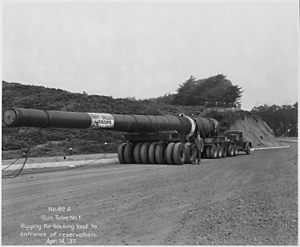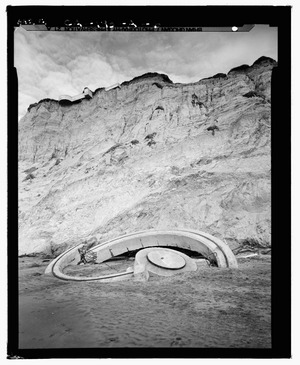Fort Funston facts for kids
Quick facts for kids Fort Funston |
|||||||||||||||||||||
|---|---|---|---|---|---|---|---|---|---|---|---|---|---|---|---|---|---|---|---|---|---|

A hang glider launches from Fort Funston Overlook, San Francisco. The launch platform is modified from a former fire control bunker.
|
|||||||||||||||||||||
| Lua error in Module:Location_map at line 420: attempt to index field 'wikibase' (a nil value). | |||||||||||||||||||||
| Location | San Francisco, California, United States | ||||||||||||||||||||
| Operated by | Golden Gate National Parks Conservancy | ||||||||||||||||||||
|
|||||||||||||||||||||
Fort Funston is a special place in San Francisco, California. It used to be a military base that protected the city's harbor. Today, it is a popular park within the Golden Gate National Recreation Area (GGNRA).
The fort was named after Frederick Funston, a Major General in the United States Army. He had strong ties to San Francisco. Fort Funston is located on Skyline Boulevard, close to Lake Merced.
This area sits on windy cliffs overlooking the Pacific Ocean. These cliffs are home to a colony of bank swallows, which are small birds. You can also find the last parts of a sand dune ecosystem here. This type of ecosystem once covered much of western San Francisco. Trails at Fort Funston are part of the California Coastal Trail.
Contents
History of Fort Funston
Early Military Days
The United States government bought this land in 1900. It was first called the Lake Merced Military Reservation. The plan was to build large mortar batteries to protect San Francisco's harbor. However, not much was built until World War I began in 1917.
The fort was renamed Fort Funston in 1917, after Major General Frederick Funston passed away. During World War I, the fort started to take shape. They built a parade ground, barracks (where soldiers lived), and several artillery batteries.
- Battery Howe: This battery had four 12-inch mortars. These were moved from another fort nearby. It was named after Walter Howe, a general who died in 1915.
- Battery Bruff: This battery had two 5-inch guns. These guns were later removed in 1920. It was named after Lawrence Bruff, an Army officer who died in 1911.
In the early 1920s, an anti-aircraft battery with three 3-inch guns was also built at the fort.
World War II Era Guns
After World War I, a treaty limited the number of large warships. This meant some powerful guns meant for battleships became available for land defense. However, only a few were set up before World War II started in 1939.
- Battery Davis: Built between 1936 and 1939, this was a very important addition. It held two huge 16-inch Navy guns. These guns weighed 143 tons each! They were moved by train in 1937. Battery Davis was the first 16-inch battery in the U.S. to be built inside a casemate (a strong, protected room) to defend against air attacks. This design was used for almost all other 16-inch batteries built during the war. It was named after Major General Richmond P. Davis, an artillery officer.
- 155 mm Guns: Around 1938, four 155 mm guns were also set up at the fort. These were placed on concrete platforms called "Panama mounts."
During World War II, Fort Funston was a key part of San Francisco's defenses. Another 16-inch battery, Battery Townsley, was built nearby. Four more 155 mm guns were added at Fort Funston, and four 40 mm anti-aircraft batteries were placed around the fort.
After the Wars
After World War II, the large gun batteries were no longer needed. However, during the Cold War (from 1953 to 1957), a 90 mm anti-aircraft gun battery was located here.
Later, Fort Funston became a Nike missile launch site from 1956 to 1963. These missiles were part of the Cold War defense system. The fort was officially closed in 1963. Eventually, it became part of the National Park Service and the Golden Gate National Recreation Area.
Over time, some of the old batteries, like Howe and Bruff, were taken down. Some of the Panama mounts have been destroyed by erosion or are now buried.
Things to Do at Fort Funston
Fort Funston has many trails for hiking or riding horses. There are also two special "Dutch sand ladders" that go down the sand dunes to the beach. The beach is known for its unique magnetic sand and strong ocean currents. Because of the currents, swimming is not recommended.
Fort Funston is a very popular place for dog owners. It is the only park in the GGNRA where dogs can be off-leash.
The strong, steady winds make the cliffs a perfect spot for hang gliding. It is considered an intermediate level (Level III) gliding site.
In 2003, a world record was set here! Erin Hemmings threw an Aerobie flying ring 1,333 feet, which is the farthest thrown object ever.
Wildlife
- Bank swallow (Riparia riparia)






